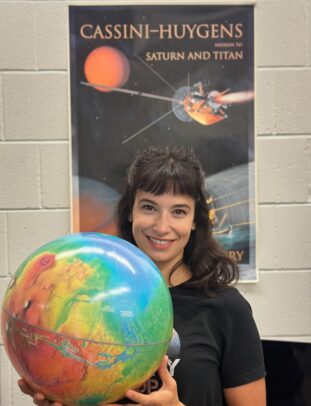How did dome craters form on Jupiter’s moons? A UIC student may have found the answer
In 1979, the Voyager spacecraft passed by Jupiter’s moons and sent back mysterious images of craters that have fascinated scientists for decades. On the ice-covered moons Ganymede and Callisto are large craters with domes in the center up to a mile tall. These structures have never been observed on any other planet or moon.
After decades of debate, a new paper led by UIC graduate student Martina Caussi proposes a mechanism that can explain how these dome craters formed. Ganymede and Callisto are both thought to have oceans beneath their icy surfaces. Caussi and her colleagues used computer models to show that the unique conditions on these moons could have transformed pit craters — another unique crater type — into domes over millions of years.
Caussi, a PhD student in the department of earth and environmental sciences, studies the icy moons Ganymede, Callisto and Europa, three of Jupiter’s four largest moons.
“These bodies are really interesting because even though they are moons orbiting Jupiter, they can be thought of as planets because of their size and complex geology,” said Caussi, a member of the research group of UIC Professor Andrew Dombard. “They are also suspected to be ocean worlds, with oceans in the interior below a layer of ice. That makes them interesting from the perspective of potential habitability.”
The dome craters on Ganymede and Callisto are unlike the craters commonly observed on Earth, our moon or even other icy celestial bodies. The physics of how common craters are created — by impacts from asteroids or comets — are well understood. But the strange dome craters suggest unique geophysical conditions on Jupiter’s icy moons influencing their formation beyond the impact process.
Caussi and Dombard collaborated with scientists at NASA, the SETI Institute and the University of California Santa Cruz to test a hypothesis that dome craters formed by a process called topographic relaxation. In this scenario, pit craters — craters with a deep circular hole at their center — gradually evolve into dome craters as ice slowly flows and rearranges itself.
“Gravity does the work,” Caussi said. “The crater wants to flatten, so in the areas where there’s excess weight, such as the rim of the crater, it’s pushing down the ice. And in the center where there’s a hole, ice pops up, and that generates a flow that makes a hole turn into an elevated dome.”
Through simulations, Caussi determined that this process is fueled by residual heat from an initial impact, as well as the warmer temperatures of the moons’ interiors. Caussi also found that the process takes “only” between 1 and 10 million years — a rapid transformation in geological time.
Caussi’s research on Jupiter’s moons landed her a role in NASA’s Europa Clipper mission, expected to launch this October, where she will conduct research on detection of gravity anomalies. She credits Dombard and UIC with connecting her to the broader space science community.
“I’m from Uruguay, and there weren’t a lot of opportunities there for space science,” Caussi said. “UIC provided me with the opportunity to study space and planets and be a part of a NASA mission, and I couldn’t have done that in my home country.”


